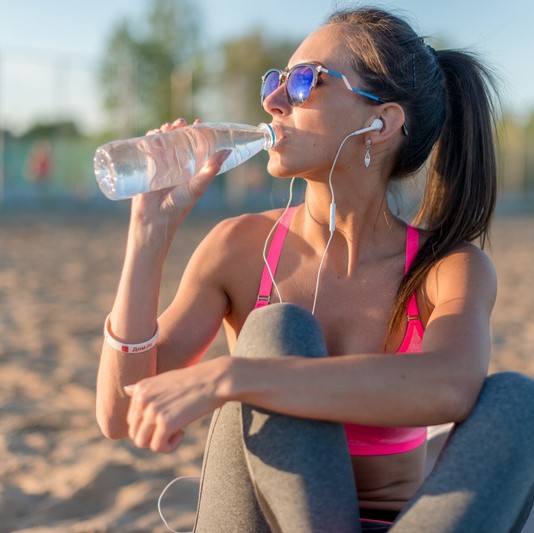Tips For Exercising In The Heat
 When you exercise, your body naturally tries to route blood flow to the surfaces of
your body so that it can, in theory, cool down because it is near wear your sweat
is evaporating. If you’re sweating a lot and not replenishing your hydration, your
blood essentially becomes thicker and your heart has to work harder to pump it through
your body to deliver oxygen and nutrients to your muscles. This sometimes creates
the feeling of “sluggish-ness” when being out in the heat for extended periods of
time, whether you’re running, hiking, biking, kayaking, or doing any other type of
outdoor exercise.
When you exercise, your body naturally tries to route blood flow to the surfaces of
your body so that it can, in theory, cool down because it is near wear your sweat
is evaporating. If you’re sweating a lot and not replenishing your hydration, your
blood essentially becomes thicker and your heart has to work harder to pump it through
your body to deliver oxygen and nutrients to your muscles. This sometimes creates
the feeling of “sluggish-ness” when being out in the heat for extended periods of
time, whether you’re running, hiking, biking, kayaking, or doing any other type of
outdoor exercise.
Here are some tips and tricks to ensure you are safe while running outside in the heat.
- First if you choose to start a running regimen, do so soon and gradually build up. It takes around 2 weeks for your body to acclimate to exercising in elevated temperatures, so use these cool mornings to your advantage and gradually build up as the temperatures get higher later on in the summer.
- Ensure you are adequately hydrated. The National Academies of Sciences, Engineering, and Medicine say that men should drink around 15 cups of water per day, and women should drink around 11 cups of water per day. People who exercise, especially outside in warmer temperatures, should drink more than the minimum recommended amount. The National Academy for Sports Medicine recommends drink 14-22 ounces of fluid 2 hours before you exercise. If you plan on exercising for longer than 60 minutes, drink a sports drink that contains up to 8% carbohydrates. If you are going to exercise for less than 60 minutes, drinking plain water is likely fine. After your workout, you ideally want to ingest 16 to 24 ounces of water for every pound of body weight lost during exercise. You can do a basic test for this by weighing yourself immediately before and immediately after exercising, and subtracting the difference. If you are an athlete or are training for a marathon, triathlon, or other race, it might help to seek out the advice of a sports dietitian to really dial in your hydration and fluid intake needs.
- Avoid running between approximately 11:00am and 3:00pm, when the sun is at its peak. Try running earlier in the day or later in the evening. Even if you run during non-peak times, remember to wear sunscreen to protect against UVA and UVB rays (even when it’s cloudy!)
- Wear light-colored clothes that are moisture-wicking to allow sweat to stay off your skin. Dark fabrics can attract more heat, and cotton clothes trap moisture next to your skin. This also includes socks! If there are areas of skin, like your armpits, shoulders, or legs that rub against seams on your clothes or other areas of skin, I’d recommend finding anti-chaffing sticks or creams to help make you more comfortable!
- If you are alone for an extended period of time outside, make sure your cell phone is charged, you have identification with you, and tell someone how long you plan to be out and where you will be going. If you start feeling dizzy, nauseous, have any cognitive declines, or your skin feels red, hot, and dry, find some shade, sit down, and drink some fluids. If you can’t do any of those things, or still feel bad, call for medical help. Check out the American Red Cross (https://www.redcross.org/get-help/how-to-prepare-for-emergencies/types-of-emergencies/heat-wave-safety.html) for more info on heat-related medical emergencies and how to help yourself or a friend.
